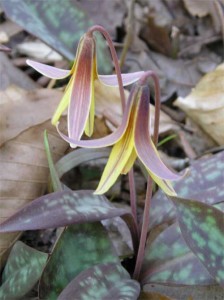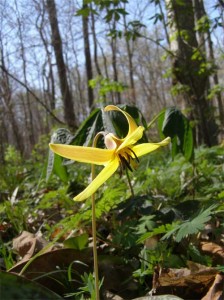Springtime panic
Originally published February 26, 2008

The dimpled trout lilies are visible for a very few weeks. Photo by Ken Moore
It’s here again, that time I year I dread most: springtime!
Terra cotta tints of elm trees and red hues of red maples announced the arrival of spring weeks ago. The tiny flowers of these native trees depend on wind currents for pollination because it’s too cold for flying insects to be effective.
Bolin Creek walker Dave Otto reported seeing trout lilies in flower on Valentine’s Day. Some folks call them dog-toothed violets, adder’s tongues or fawn lilies. Taking “a closer look†will give you some hints about these common names.
For me, the onslaught of springtime is symbolized by the first appearance of the speckled-patterned leaves of the trout lily, and every year that sends me into a panic. During the springtime, too much happens too quickly. I can’t keep up with it all!
I remember past years when I allowed myself to seem too busy to get out along the forest trails to catch the trout lilies. Within just a few short weeks, those beautiful little wildflowers were gone for another whole year; I had missed them again!
Being natural opportunists, some of our woodland plants emerge in the late winter to take advantage of the sunlight before the leafy canopy shades the forest floor. They grow, flower, make seed and return to dormancy in just a few short weeks. This year, I’m going to make certain that I catch the trout lilies. They are really special, and perhaps one of the most frequently photographed of all wildflowers.
Consider William Blake’s “To see a world in a grain of sand/And a heaven in a wildflower/Hold infinity in the palm of your hand/And eternity in an hour†when you behold a trout lily. You may have to practice some “belly botany†by lying on the ground to peer up into a trout lily flower to get a really good look.
For years and years, I’ve believed that we have only one species of trout lily in our area, but now I’m advised that we have two. The common one that we see in our local woods is the dimpled trout lily, Erythronium umbilicatum, thusly called because of the little indentation at the tip of the seed pod. The more common one flowers earlier and is smaller than the rarer American trout lily, E. americanum, which is larger and flowers a little later. If you walk different trails frequently, you may discover both of them.
Don’t be concerned about which one you are seeing; just make certain you get yourself out in the woods to see them, to “hold infinity in the palm of your hand.†If you don’t get out on weekly walks at this time of year, you’re missing a lot.
If you want a few trout lilies in your own garden, check out the Botanical Garden’s plant sale. There are pots of seedling trout lilies on the sale benches right now. Get a couple and in a few years you’ll have your own little patch and you won’t have to panic about missing them!
Special Note: I’m going out on a trout lily search on Saturday, March 7, in Carrboro’s Adams Tract nature preserve. You’re welcome to join me at 3:00 p.m. at the trailhead kiosk below the playground of Wilson Park. Bring along some kids to lead the way!

It helps to lie on the ground to look up into the flower of an American trout lily. Photo by Ken Moore


Comments are closed.